Agricultural Support Policies and China’s Cyclical Evolutionary Path of Agricultural Economic Growth
Abstract
1. Introduction
2. Methods and Materials
2.1. Nonlinear MS (M)-AR (p) Model Construction and Model Estimation
2.2. Data Selection for China’s Agricultural Economic Growth
3. Results
3.1. Growth Rate Dynamic Trajectory Analysis
3.2. The Parameter Estimation of the MSM (M)-AR (p) Model
3.3. The Dynamic Shift Probabilities of China’s Agricultural Growth Regime
3.4. Estimated Average Duration of Each Regime of China’s Agricultural Economy
3.5. Filter Probability and Smoothing Probability
4. Discussion
4.1. Contrast to Prior Studies
4.2. Policy Recommendations
5. Conclusions
Author Contributions
Funding
Institutional Review Board Statement
Informed Consent Statement
Data Availability Statement
Acknowledgments
Conflicts of Interest
Appendix A
| Year | Summary of Major Agricultural Policies |
|---|---|
| 2002 | Regulations on Restoring Farmland to Forest Returning farmland to forest is to protect and improve the ecological environment in the west, the sloping arable land that is prone to soil erosion and the arable land that is prone to land sanding, stop cultivation in a planned and step-by-step manner. In line with the principle that it is appropriate to plant trees, irrigation, grass, and the combination of trees, irrigation, and grass, planting forests and grasses according to local conditions to restore forest and grass vegetation. The state implements the system of funds and food subsidies for returning farmland to forest, the state provides appropriate subsidized food, seedling planting fees, and cash (living expenses) subsidies to those returning farmland to forest for a certain period of time without compensation according to the approved area of returning farmland to forest. The Yellow River Basin and the northern region, each mu of fallow land is subsidized with 100 kg of raw food and CNY 20 of cash per year, and at least 8 years for ecological forest, 5 years for economic forest, and 2 years for grass. Each mu of fallow land and forest able wasteland subsidies has a seedling reforestation fee of CNY 50. |
| 2003 | The decision of the State Council of the Communist Party of China (CPC) Central Committee on Accelerating the Development of Forestry Stabilize the land contract relationship and allow the reasonable transfer of land use rights under the principle of law, voluntarily and with compensation. Development of private fast-growing forests and its related industries, the implementation of agroforestry compound management, turning potential resource advantages into realistic economic advantages, to achieve the effect of increasing farmers’ income, agricultural efficiency and environmental improvement. Encourage pulp and paper enterprises to cross-region, cross-sector, cross-ownership to establish a paper forest base. In the forestry policy, the first should be clear property rights, with the responsibility to the household. In accordance with the principle of “who makes who has, who operates who gains,” further extend the use of forest land, allowing inheritance, transfer, mortgage, lease, and access to the secondary market flow. Second, to relax logging restrictions and revitalize forest assets. |
| 2004 | Opinions of the State Council of the Central Committee of the Communist Party of China on Several Policies to Promote Increased Incomes of Farmer On 31 December 2003, the “Opinions of the State Council of the Central Committee of the Communist Party of China on Several Policies to Promote Increased Incomes for Farmers” was issued and published on 9 February 2004. A prominent problem of agricultural and rural development at that time was the difficulty of increasing farmers’ income. The income gap between urban and rural residents widened from 1.8:1 in the 1980s to 3.1:1, and the difficulty of increasing farmers’ income not only restricted the development of the rural economy but also affected the growth of the national economy as a whole. The “Opinions” proposed to “adhere to the ‘more to give, less to take, let live’ policy, adjust the agricultural structure, expand employment of farmers, accelerate scientific and technological progress, deepen rural reform, increase agricultural investment, strengthen support for agricultural protection, and strive to achieve a relatively rapid growth in farmers’ income, as soon as possible to reverse the income gap between urban and rural residents The trend of widening income gap between urban and rural residents.” The document contains 22 articles, putting forward a series of high gold content, pointing to clear and practical policy measures. |
| 2005 | Opinions of the State Council of the Central Committee of the Communist Party of China on Several Policies to Further Strengthen Rural Work and Improve Comprehensive Agricultural Production Capacity In February 2005, the “Opinions of the State Council of the Central Committee of the Communist Party of China on a number of policies to further strengthen rural work to improve the comprehensive production capacity of agriculture” was issued. The document pointed out the current and future period, to strengthen the construction of agricultural infrastructure, accelerate the progress of agricultural science and technology, improve the comprehensive production capacity of agriculture, as a major and urgent strategic task, and effectively grasp it. Additionally, stressed that we should “strictly protect the arable land as the basis, to strengthen the construction of agricultural water conservancy as the focus, to promote scientific and technological progress as a support, to improve the service system as a guarantee, and strive to make efforts in the next few years, so that the material and technical conditions of agriculture significantly improved, land product rate and labor productivity significantly increased, the overall efficiency and competitiveness of agriculture significantly enhanced.” |
| 2006 | Several Opinions of the State Council of the CPC Central Committee on Promoting the Construction of a New Socialist Countryside On 21 February 2006, the “Opinions of the State Council of the Central Committee of the Communist Party of China on Promoting the Construction of a New Socialist Countryside” was released. The document points out that building a new socialist countryside is a major historical task in China’s modernization process. Only by developing the rural economy, building a good home for farmers, and enabling them to lead a prosperous life can we ensure that all people share the fruits of economic and social development and continuously expand domestic demand and promote sustainable development of the national economy. The full text of the document contains 32 articles, eight parts. The document emphasizes the need to adhere to the development of the rural economy as the center, to further liberate and develop the rural productive forces. Adhere to the “more to less to take the live” approach, focusing on the “more to” efforts to mobilize a wide range of forces to participate. |
| Decision of the Standing Committee of the National People’s Congress on the Abolition of the Regulations of the People’s Republic of China on Agricultural Tax On 29 December 2005, the 19th meeting of the Standing Committee of the 10th National People’s Congress decided to repeal the Regulations of the People’s Republic of China on Agricultural Tax from 1 January 2006. As a result, the state no longer levies a separate tax on agriculture. | |
| 2007 | Several Opinions of the State Council of CPC Central Committee on Actively Developing Modern Agriculture and Solidly Promoting the Construction of a New Socialist Countryside On 29 January 2007, the “CPC Central Committee and State Council on the active development of modern agriculture to solidly promote the construction of a new socialist countryside of a number of opinions” was published. The document clearly pointed out that the construction of a new socialist countryside should put the construction of modern agriculture in the first place. The construction of the new socialist countryside has received an enthusiastic response from the grassroots. However, there are some deviations in practice. Emphasis on the new rural construction should put the development of modern agriculture in the first place, which is conducive to the serious implementation of the spirit of the Fifth Plenary Session of the Sixteenth Central Committee around the world, the new socialist countryside construction to move forward solidly and healthily. The document proposes to equip agriculture with modern material conditions, transform agriculture with modern science and technology, upgrade agriculture with modern industrial systems, promote agriculture with modern forms of operation, lead agriculture with modern development concepts, develop agriculture with training new farmers, improve the level of agricultural water conservancy, mechanization and information technology, improve land product rate, resource utilization and agricultural labor productivity, improve agricultural quality, efficiency and competitiveness. |
| 2008 | Several Opinions of the CPC Central Committee and State Council on Effectively Strengthening Agricultural Infrastructure Construction to Further Promote Agricultural Development and Increase Farmers’ Income On 30 January 2008, the “Opinions of the Central Committee of the Communist Party of China and the State Council on Effectively Strengthening Agricultural Infrastructure to Further Promote Agricultural Development and Increase Farmers’ Income” was announced. That year’s Central Document No. 1 deepened the requirements of last year’s Central Document No. 1 on developing modern agriculture as the primary task of new rural construction, grasping the key link between maintaining economic stability and promoting agricultural development, and also taking into account the work of all aspects of rural areas. There are more than 40 policy requirements and measures in the whole document, among which the agriculture and farmers can be directly benefited as “three obvious,” “three adjustments,” “four increases,” “four improvements,” “four increase,” and “two substantial.” Embodies the benefits to farmers to gradually increase, with the growth of national financial resources to the “three rural” support to further increase the requirements. |
| General Office of the State Council on strengthening the work of fishery production safety notice Comprehensively implement the production safety responsibility system for fisheries, further strengthen safety management and supervision, increase investment, improve infrastructure, improve technical equipment, improve laws and regulations, and constantly improve the safety quality of practitioners and disaster prevention and avoidance capabilities, and strive to build a long-term mechanism for fisheries production safety, effectively curb fishing safety accidents, effectively protect the lives and property of the people, and promote the safe development of the fisheries economy. Expansion of a number of new safety from the wind, supporting the perfect fishing port, so that the national coastline within an average of 200 km above the first-class fishing port is able to provide services for 45% of the marine fishing vessels. Key fishing ports were equipped with safety monitoring equipment, the construction of marine fisheries ship management dynamic monitoring system, fishing vessel safety equipment testing, and inspection base and fisheries crew training base, so that serious fishing vessel accidents are significantly control. By 2015, the formation of a more complete fishery production safety support and security system, fisheries safety supervision and disaster prevention and mitigation capabilities are significantly enhanced, the quality of practitioners have improved to a certain extent, the fisheries safety production situation has improved significantly. Specific measures include: Strengthening the construction of fishing port safety infrastructure, vigorously improve the quality of fishing vessel safety, and actively promote the construction of fisheries safety communication network, and strive to improve fisheries safety technology and equipment. Increase financial investment, improve the production of fishery safety laws and regulations and systems, promote scientific and technological advances in fisheries safety, improve fisheries safety risk protection mechanism, etc. | |
| 2009 | Several Opinions of the CPC Central Committee and State Council on Promoting Stable Development of Agriculture and Sustained Incomes of Farmers in 2009 The 2009 No. 1 Document “the CPC Central Committee and the State Council on 2009 to promote the stable development of agriculture and farmers continue to increase income of a number of opinions” presents four new highlights. First, the support for farmers to grow food has been increased again. Including increased investment in agricultural infrastructure and scientific and technological services, and increased direct subsidies to agriculture. Second, to increase efforts to solve the problem of employment of migrant workers. The document proposes urban and rural infrastructure construction and new public welfare jobs, as much as possible to use more migrant workers. To take work for food and other ways to guide farmers to participate in agricultural and rural infrastructure construction. Third, the rural livelihood construction focus on the rural power grid construction, rural road construction, rural drinking water safety project construction, rural biogas construction, rural housing renovation, and other five areas. Fourth, the transfer of agricultural land emphasizes further regulation. For adhering to the basic rural management system, the 2009 No. 1 Document first emphasized the implementation and protection of farmers’ land rights and interests, focusing on two aspects of work: The ownership of collectively owned land is further defined clearly and its rights and interests are protected. The contracted land plots are identified, registered, and certified. |
| 2010 | Several Opinions of the State Council of the CPC Central Committee on Increasing the Efforts to Coordinate Urban and Rural Development to Further Strengthen the Foundation of Agricultural and Rural Development In early 2010, the “Opinions of the State Council of the Central Committee of the Communist Party of China on Increasing the Efforts to Integrate Urban and Rural Development to Further Strengthen the Foundations of Agricultural and Rural Development” was released, further improving and strengthening good policies for the “three rural areas” on the basis of maintaining policy continuity and stability, and putting forward a series of new major principles and measures, including improve the policy system for a strong agricultural policy system, promote the allocation of resources to rural areas, improve the level of modern agricultural equipment, promote the transformation of agricultural development, accelerate the improvement of rural people’s livelihood, narrow the gap between urban and rural public utilities development, coordinate urban and rural reform, enhance the vitality of agricultural and rural development. Strengthen the construction of rural grass-roots organizations, and consolidate the Party’s ruling base in rural areas. The document places special emphasis on institutional innovation to promote the development of urbanization. Propose to actively and steadily promote urbanization, improve the level of urban planning and development quality, to strengthen the development of small and medium-sized cities and small towns as the focus. Deepen the reform of the household registration system, accelerate the implementation of policies to relax the conditions for settling in small and medium-sized cities and small towns, especially in counties and central towns, and promote the eligible agricultural transfer population to settle in cities and towns and enjoy the same rights and interests as local urban residents. |
| 2011 | The CPC Central Committee and State Council Decision on Accelerating the Reform and Development of Water Resources On 29 January 2011, the “CPC Central Committee and the State Council on the decision to accelerate the reform and development of water conservancy” was released, the theme of accelerating the reform and development of water conservancy. This is the first time in 62 years since the founding of new China, the central document on the work of water resources for comprehensive deployment. The document proposes to put the work of water resources on a more prominent position, focusing on accelerating the construction of agricultural water conservancy, to promote the leapfrog development of water resources. Proposes to strive for 5 to 10 years of efforts to fundamentally reverse the situation of the obvious lag in water conservancy construction. |
| 2012 | The CPC Central Committee and State Council on Accelerating Agricultural Science and Technology Innovation to Continuously Enhance the Ability to Ensure the Supply of Agricultural Products The “Opinions of the State Council of the CPC Central Committee on Accelerating Agricultural Science and Technology Innovation to Continuously Enhance the Supply Assurance Capability of Agricultural Products,” released in February 2012, highlights the deployment of agricultural science and technology innovation and makes the promotion of agricultural science and technology innovation the focus of the work of the “three rural areas.” Two of the most popular policies: One is the public, basic, social discourse on agricultural science and technology. The other is the township agricultural personnel salaries and wages to be linked to the average income of local institutions. The grassroots agricultural extension system reform and construction demonstration county project basically covers all agricultural counties, agricultural technology extension institutions conditions, and construction projects cover all townships. |
| 2013 | Several Opinions of the CPC Central Committee and State Council on Accelerating the Development of Modern Agriculture and Further Enhancing the Vitality of Rural Development On 31 January 2013, the “Opinions of the State Council of the Central Committee of the Communist Party of China on Accelerating the Development of Modern Agriculture and Further Enhancing the Vitality of Rural Development” was released. The document makes comprehensive arrangements for “accelerating the development of modern agriculture and further enhancing the vitality of rural development,” requiring that we must respond to the changes in the stage, follow the laws of development, enhance the sense of worry, and make national efforts to persistently strengthen agriculture, benefit the countryside, and enrich farmers. In accordance with the work objectives of ensuring supply and income, reform and innovation to add vitality, increase the efforts of rural reform, policy support, science and technology-driven efforts. |
| 2014 | Several Opinions of the CPC Central Committee and State Council on Comprehensively Deepening Rural Reform and Accelerating Agricultural Modernization In January 2014, the “Opinions of the State Council of the Central Committee of the Communist Party of China on Comprehensively Deepening Rural Reform and Accelerating Agricultural Modernization” was released. It is pointed out that to comprehensively deepen rural reform, we should adhere to the direction of socialist market economy reform, handle the relationship between the government and the market, and stimulate rural economic and social vitality. Encourage exploration and innovation, and promote land transfer in an orderly manner under the premise of protecting the interests of farmers. Tailor the reform to local conditions, proceed in a gradual and orderly manner, and do not engage in a “one-size-fits-all” approach or pursue a one-step solution. Allow the adoption of different, transitional systems and policy arrangements. To integrate urban and rural linkages, give farmers more property rights, promote equal exchange of urban and rural factors and balanced allocation of public resources, so that farmers can participate equally in the modernization process and share the fruits of modernization. |
| 2015 | Several Opinions of the CPC Central Committee and State Council on Increasing Reform and Innovation to Accelerate the Construction of Agricultural Modernization The 2015 Central Document No. 1, “Opinions of the State Council of the Central Committee of the Communist Party of China on Increasing Reform and Innovation to Accelerate the Construction of Agricultural Modernization,” points out that we should actively adapt to the new normal of economic development, follow the general requirements of stabilizing food and increasing income, improving quality and efficiency, and driving innovation, continue to comprehensively deepen rural reform, comprehensively promote the construction of the rule of law in rural areas, and promote the simultaneous development of new industrialization, information technology, urbanization and agricultural modernization. Efforts to improve food production capacity to explore new potential, in the optimization of agricultural structure to open up new ways, in the transformation of agricultural development to seek new breakthroughs, in the promotion of farmers to obtain new results on income, in the construction of a new countryside to take new steps to provide strong support for sustainable and healthy economic and social development. |
| 2016 | Several Opinions of the State Council of the Central Committee of the Communist Party of China on Implementing the New Concept of Development and Accelerating Agricultural Modernization to Achieve the Goal of Comprehensive Well-off In January 2016, the “Opinions of the State Council of the Central Committee of the Communist Party of China on Implementing the New Concept of Development and Accelerating Agricultural Modernization to Achieve the Goal of Overall Well-off” was released. All regimes and departments are required to firmly establish and thoroughly implement the development concept of innovation, coordination, green, openness and sharing, vigorously promote agricultural modernization, and ensure that hundreds of millions of farmers will join the people of the country to move into an overall well-off society. The document proposes to use the new concept of development to crack the “three rural” new problems, thicken the advantages of agricultural and rural development, increase innovation-driven efforts to promote the supply-side structural reform of agriculture, accelerate the transformation of agricultural development, to maintain stable development of agriculture, and farmers continue to increase income. |
| 2017 | Several Opinions of the State Council of the Central Committee of the Communist Party of China on Deepening the Structural Reform on the Supply Side of Agriculture and Accelerating the Cultivation of New Dynamic Energy for Agricultural and Rural Development In February 2017, the “CPC Central Committee and State Council on deepening the supply-side structural reform of agriculture to accelerate the cultivation of new dynamics of agricultural and rural development of a number of opinions” was released. The document clearly points out that the main line of work for the current and future period of the “three rural areas” should be to deeply promote the structural reform of the agricultural supply side. After years of efforts, China’s agricultural and rural development has entered a new historical stage. The main contradiction in agriculture from the total lack of structural contradictions, highlighted by the stage of oversupply and undersupply coexist, the main aspect of the contradiction in the supply side. Urgent requirements to further promote the supply-side structural reform of agriculture, accelerate the cultivation of new dynamics of agricultural and rural development. The document points out that to promote the supply-side structural reform of agriculture, based on ensuring national food security, closely around the changes in market demand, to increase farmers’ income, to ensure effective supply as the main goal, to improve the quality of agricultural supply as the main direction, to institutional reform and institutional innovation as the fundamental way. Additionally, stressed that the supply-side structural reform of agriculture is a long-term process, we must face the difficulties and challenges, try to reduce the cost of reform, and actively prevent the risk of reform. At the same time, the further implementation of the rural land three rights of separation, to encourage the appropriate scale of land transfer. |
| 2018 | Opinions of the State Council of the Central Committee of CPC on Implementing the Strategy of Rural Revitalization On 2 January 2018, the “Opinions of the State Council of the Central Committee of the Communist Party of China on the Implementation of the Rural Revitalization Strategy” was released. Around the implementation of the rural revitalization strategy, the document plans a series of major initiatives and is the top-level design for the implementation of the rural revitalization strategy. The document has two important features: First, it is comprehensive in management. It makes comprehensive arrangements for the overall promotion of rural economy, politics, culture, society, ecological civilization, and the construction of the Party. The second is to manage the long-term. In accordance with the strategic arrangement proposed by the 19th Party Congress of building a moderately prosperous society and achieving the second century goal in two stages, the document deploys the three stages of implementing the rural revitalization strategy according to the principle of “far and coarse, near and fine.” |
References
- Burns, A.F.; Wesley, C.M. Measuring Business Cycles; National Bureau of Economic Research: Cambridge, MA, USA, 1946; pp. 384–417. [Google Scholar]
- Fan, S. Public Expenditures, Growth, and Poverty: Lessons from Developing Countries. Asean Econ. Bull. 2009, 26, 235. [Google Scholar] [CrossRef]
- Pan, D.; Ying, R. Research on the relationship between water resources and agricultural economic growth in China—Based on panel VAR model. China Popul. Resour. Environ. 2012, 22, 161–166. [Google Scholar]
- Wu, Q.; Zhou, X.; Feng, Z. The impact of infrastructure on agricultural economic growth—A study based on inter-provincial panel data of China from 1995–2010. China Econ. Issues 2015, 3, 29–37. [Google Scholar]
- Ofana, O.G.; Effiong, C.E.; Eko, E.O. Constraints to agricultural development in Nigeria. Int. J. Dev. Econ. Sustain. 2016, 4, 19–33. [Google Scholar]
- Sylwester, K. R&D and economic growth. Knowl. Soc. 2001, 13, 71–84. [Google Scholar] [CrossRef]
- Andersen, M.A. Public investment in U.S. agricultural R&D and the economic benefits. Food Policy 2015, 51, 38–43. [Google Scholar] [CrossRef]
- Wang, J. Research on the Interactive Relationship between China’s Agricultural Research Investment and Agricultural Eco-nomic Growth. Agric. Technol. Econ. 2009, 1, 103–109. [Google Scholar]
- Yang, C.; Zhang, J.; Zhao, K. Demonstration on the relationship between agricultural science and technology resources and agricultural economic development. China Popul. Resour. Environ. 2011, 21, 113–118. [Google Scholar]
- Kirchner, M.; Schmidt, J.; Kindermann, G.; Kulmer, V.; Mitter, H.; Prettenthaler, F.; Rüdisser, J.; Schauppenlehner, T.; Schönhart, M.; Strauss, F.; et al. Ecosystem services and economic development in Austrian agricultural landscapes—The impact of policy and climate change scenarios on trade-offs and synergies. Ecol. Econ. 2015, 109, 161–174. [Google Scholar] [CrossRef]
- Abdul-Rahim, A.S.; Sun, C.; Noraida, A.W. The Impact of Soil and Water Conservation on Agricultural Economic Growth and Rural Poverty Reduction in China. Sustainability 2018, 10, 4444. [Google Scholar] [CrossRef]
- Qiao, Z.; Jiao, F.; Li, N. Changes in China’s Rural Economic System and Agricultural Growth: An Empirical Analysis of China’s Agricultural Growth from 1978 to 2004. Econ. Res. 2006, 7, 73–82. [Google Scholar]
- Jin, S.; Klaus, D. Land rental markets in the process of rural structural transformation: Productivity and equity impacts from China. J. Comp. Econ. 2009, 37, 629–646. [Google Scholar] [CrossRef]
- Deininger, K.; Jin, S.; Xia, F.; Huang, J. Moving off the farm: Land institutions to facilitate structural transformation and agricultural productiv-ity growth in China. World Dev. 2014, 59, 505–520. [Google Scholar] [CrossRef]
- Lerman, Z. Land reform, farm structure, and agricultural performance in CIS countries. China Econ. Rev. 2009, 20, 316–326. [Google Scholar] [CrossRef]
- Guth, M.; Smędzik-Ambroży, K.; Czyżewski, B.; Stępień, S. The Economic Sustainability of Farms under Common Agricultural Policy in the European Union Countries. Agriculture 2020, 10, 34. [Google Scholar] [CrossRef]
- Susilastuti, D. Poverty Reduction Models: Indonesian Agricultural Economic Approach. Eur. Res. Stud. J. 2017, 20, 164–176. [Google Scholar] [CrossRef]
- Boonyanam, N. Agricultural economic zones in Thailand. Land Use Policy 2020, 99, 102774. [Google Scholar] [CrossRef]
- Chaudhary, D. Agricultural Policies and Rural Development in Nepal: An Overview. Res. Nepal J. Dev. Stud. 2018, 1, 34–46. [Google Scholar] [CrossRef]
- Chanie, A.M.; Pei, K.Y.; Lei, Z.; Zhong, C.B. Rural Development Policy: What does Ethiopia Need to Ascertain from China Rural Development Policy to Eradicate Rural Poverty? Am. J. Rural. Dev. 2018, 6, 79–93. [Google Scholar] [CrossRef]
- Corral, S.; Díaz, A.S.; Monagas, M.D.C.; García, E.C. Agricultural Policies and Their Impact on Poverty Reduction in Developing Countries: Lessons Learned from Three Water Basins in Cape Verde. Sustainability 2017, 9, 1841. [Google Scholar] [CrossRef]
- Pernechele, V.; Jean, B.; Léopold, G. Agricultural policy incentives in sub-Saharan Africa in the last decade (2005–2016). Monit. Anal. Food Agric. Policies (MAFAP) Synth. Study 2018, 2143-2019-4790. [Google Scholar] [CrossRef]
- Grabowski, R. Agricultural distortions and structural change. J. Asian Econ. 2013, 24, 17–25. [Google Scholar] [CrossRef]
- Akbar, M.; Jamil, F. Monetary and fiscal policies’ effect on agricultural growth: GMM estimation and simulation analysis. Econ. Model. 2012, 29, 1909–1920. [Google Scholar] [CrossRef]
- Fang, H. The impact of monetary supply shocks on the agricultural economy under the conditions of an open economy—Based on the causal graph method. China Rural Econ. 2011, 8, 41–53. [Google Scholar]
- Chen, D. Monetary policy, inflationary pressure and agricultural product prices. China Soft Sci. 2014, 7, 185–192. [Google Scholar]
- Sánchez-Picón, A.; Aznar-Sánchez, J.A.; García-Latorre, J. Economic cycles and environmental crisis in arid southeastern Spain. A historical perspective. J. Arid Environ. 2011, 75, 1360–1367. [Google Scholar] [CrossRef]
- Palma, I.P.; Toral, J.N.; Vázquez, M.R.P.; Fuentes, N.F.; Hernández, F.G. Historical changes in the process of agricultural development in Cuba. J. Clean. Prod. 2015, 96, 77–84. [Google Scholar] [CrossRef]
- Chatterton, J.; Graves, A.; Audsley, E.; Morris, J.; Williams, A. Using systems-based life cycle assessment to investigate the environmental and economic impacts and benefits of the livestock sector in the UK. J. Clean. Prod. 2015, 86, 1–8. [Google Scholar] [CrossRef]
- Ge, Y.; Zhao, R.; Liu, D. Causal factors of cyclical fluctuations in China’s agricultural economy and their transmission mechanisms. Agric. Technol. Econ. 1998, 1, 46–49. [Google Scholar]
- Guo, W. A study of agricultural volatility in China. Rural Econ. Soc. 1991, 2, 1–9. [Google Scholar]
- Xi, L.; Peng, K. Analysis of China’s rural economic system changes and agricultural cyclical growth. China Popul. Resour. Environ. 2010, 20, 123–129. [Google Scholar]
- Sun, X. Analysis of the characteristics of my country’s agricultural cycle fluctuations. Learn. Explor. 2011, 2, 168–169. [Google Scholar]
- Sui, J.; Cai, Q. Identification of the path evolution of China’s agricultural business cycle: Practice and experience since the reform and opening up. China Rural Econ. 2016, 9, 30–43. [Google Scholar]
- Cheng, S.; López, M.A. Synergy analysis of agricultural economic cycle fluctuation based on ant colony algorithm. Open Phys. 2018, 16, 978–988. [Google Scholar] [CrossRef]
- Yu, J.; Wu, J. The Sustainability of Agricultural Development in China: The Agriculture–Environment Nexus. Sustainability 2018, 10, 1776. [Google Scholar] [CrossRef]
- Hejazi, M.; Marchant, M.A. China’s evolving agricultural support policies. Choices 2017, 32, 1–7. [Google Scholar]
- Huang, J.; Guolei, Y. Understanding recent challenges and new food policy in China. Glob. Food Secur. 2017, 12, 119–126. [Google Scholar] [CrossRef]
- Huang, P.C.C. Is the family farm the approach for agricultural development in China? Open Times 2014, 2, 176–194. [Google Scholar]
- Yao, Y.; Chen, W.; Li, X. Research on the relationship between environmentally friendly agricultural technology innovation and agricultural economic growth. China Popul. Resour. Environ. 2014, 24, 122–130. [Google Scholar]
- Wang, L. Impact of ecological land use change on agricultural economy in the farming pastoral ecotone of northern China. China Rural Econ. 2009, 4, 80–85. [Google Scholar]
- Skalin, J.; Teräsvirta, T. Another look at Swedish business cycles, 1861–1988. J. Appl. Econ. 1999, 14, 359–378. [Google Scholar] [CrossRef]
- Hamilton, J.D. Analysis of time series subject to changes in regime. J. Econ. 1990, 45, 39–70. [Google Scholar] [CrossRef]
- Leamer, E.; Potter, S. A Nonlinear Model of the Business Cycle; Federal Reserve Bank of New York: New York, NY, USA, 2003. [Google Scholar]
- Moolman, E. A Markov switching regime model of the South African business cycle. Econ. Model. 2004, 21, 631–646. [Google Scholar] [CrossRef]
- de Medeiros, O.R.; Sobral, Y.D. A Markov Switching Regime Model of the Brazilian Business Cycle. SSRN Electron. J. 2007. [Google Scholar] [CrossRef]
- Dicle, O. Sectoral Business Cycle Asymmetries and Regime Shifts: Evidence from Turkey. Appl. Econ. J. 2019, 26, 59–80. [Google Scholar]
- Liu, J.; Sui, J.; Yan, C. My country’s economic cycle wave dynamics and economic policy orientation under the financial crisis. China Ind. Econ. 2009, 8, 37–46. [Google Scholar]
- Chen, L.; Liu, H. Research on the Asymmetry and Persistence of my country’s Business Cycle Fluctuations. Econ. Res. 2007, 4, 43–52. [Google Scholar]
- Liu, J.; Sui, J. A Test of the Relationship between the Uncertainty of China’s Currency Growth and Economic Growth (1980–2008). Chin. Soc. Sci. 2010, 4, 74–86, 221–222. [Google Scholar]
- Sui, J.; Song, D. Analysis of the changes in the dynamic path of China’s agricultural economic growth. Learn. Explor. 2014, 6, 106–109. [Google Scholar]
- Krolzig, H.-M. Markov-Switching Vector Auto Regressions: Modelling, Statistical Inference, and Application to Business Cycle Analysis; Springer Science & Business Media: Berlin, Germany, 2013; Volume 454. [Google Scholar]
- Hodrick, R.J.; Prescott, E.C. Postwar U.S. Business Cycles: An Empirical Investigation. J. Money Crédit Bank. 1997, 29, 1–16. [Google Scholar] [CrossRef]
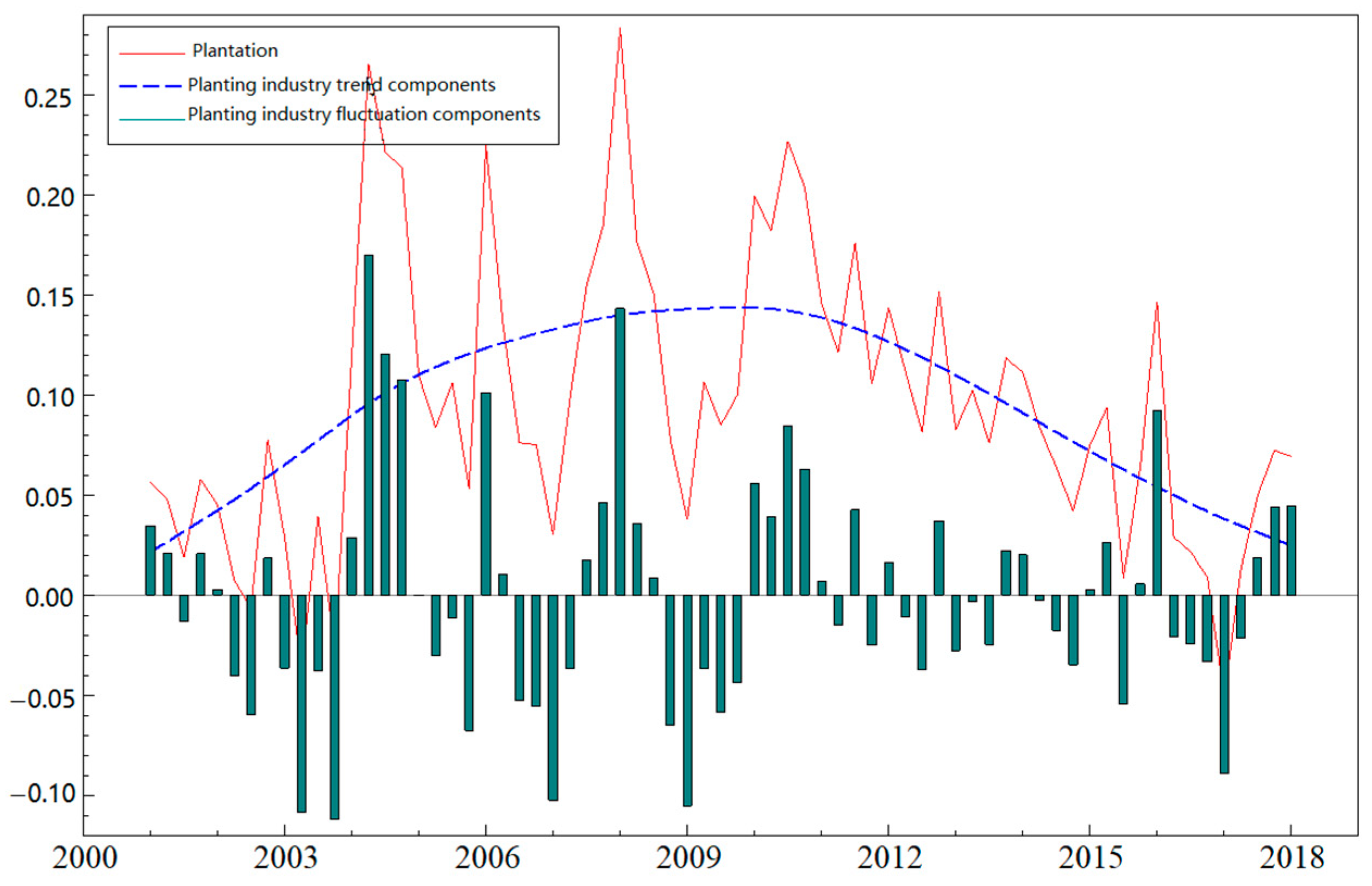
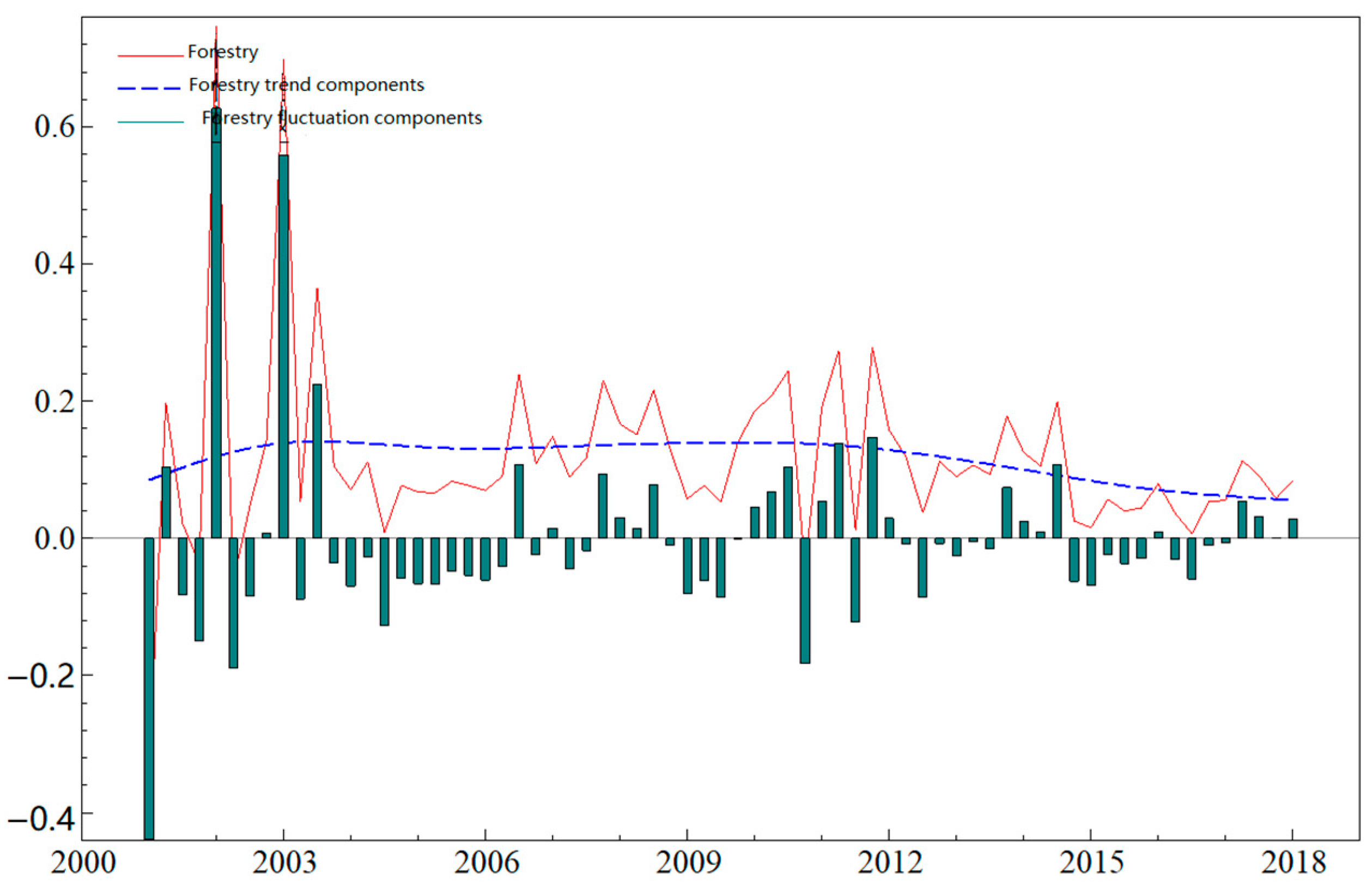
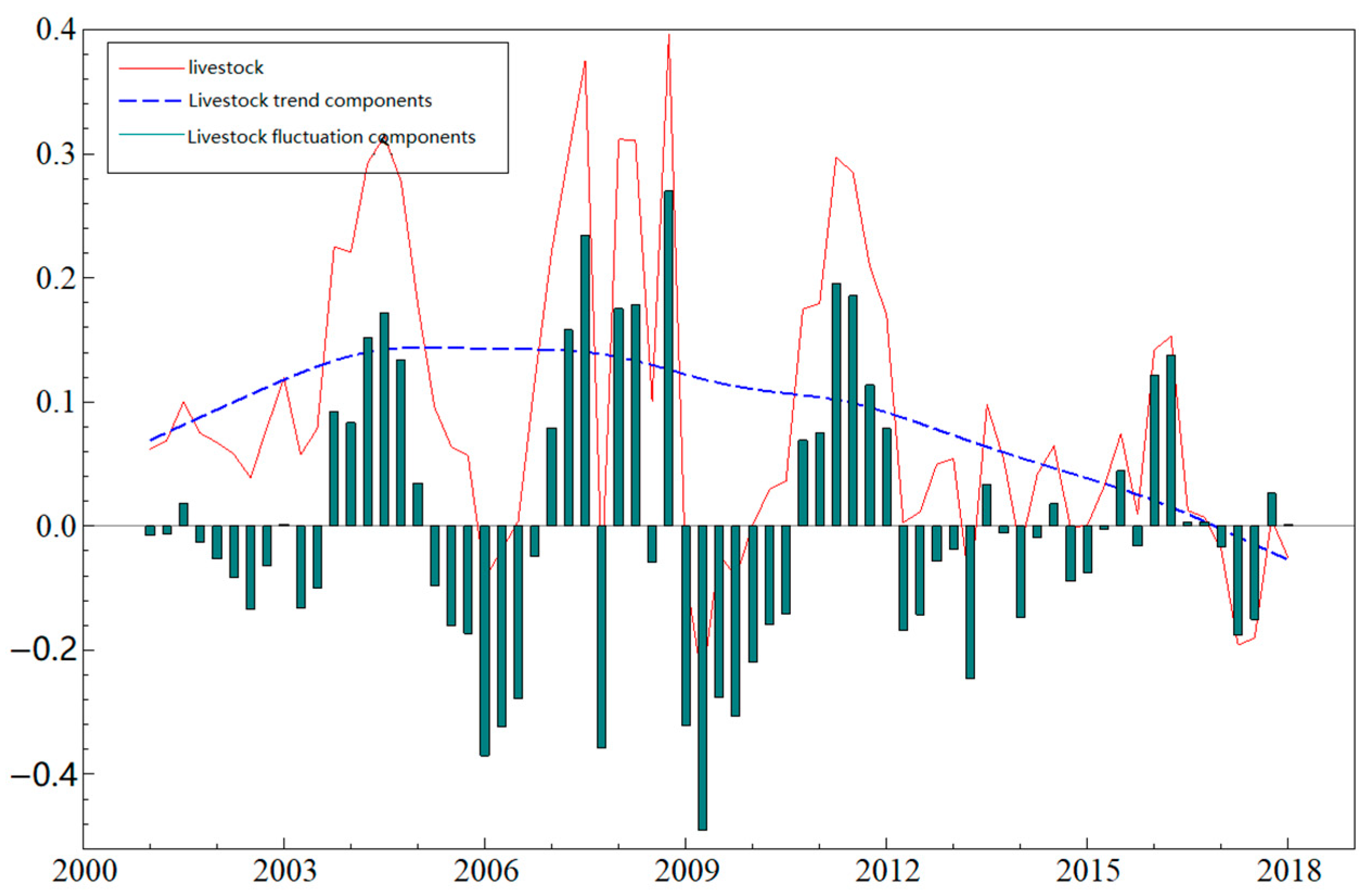
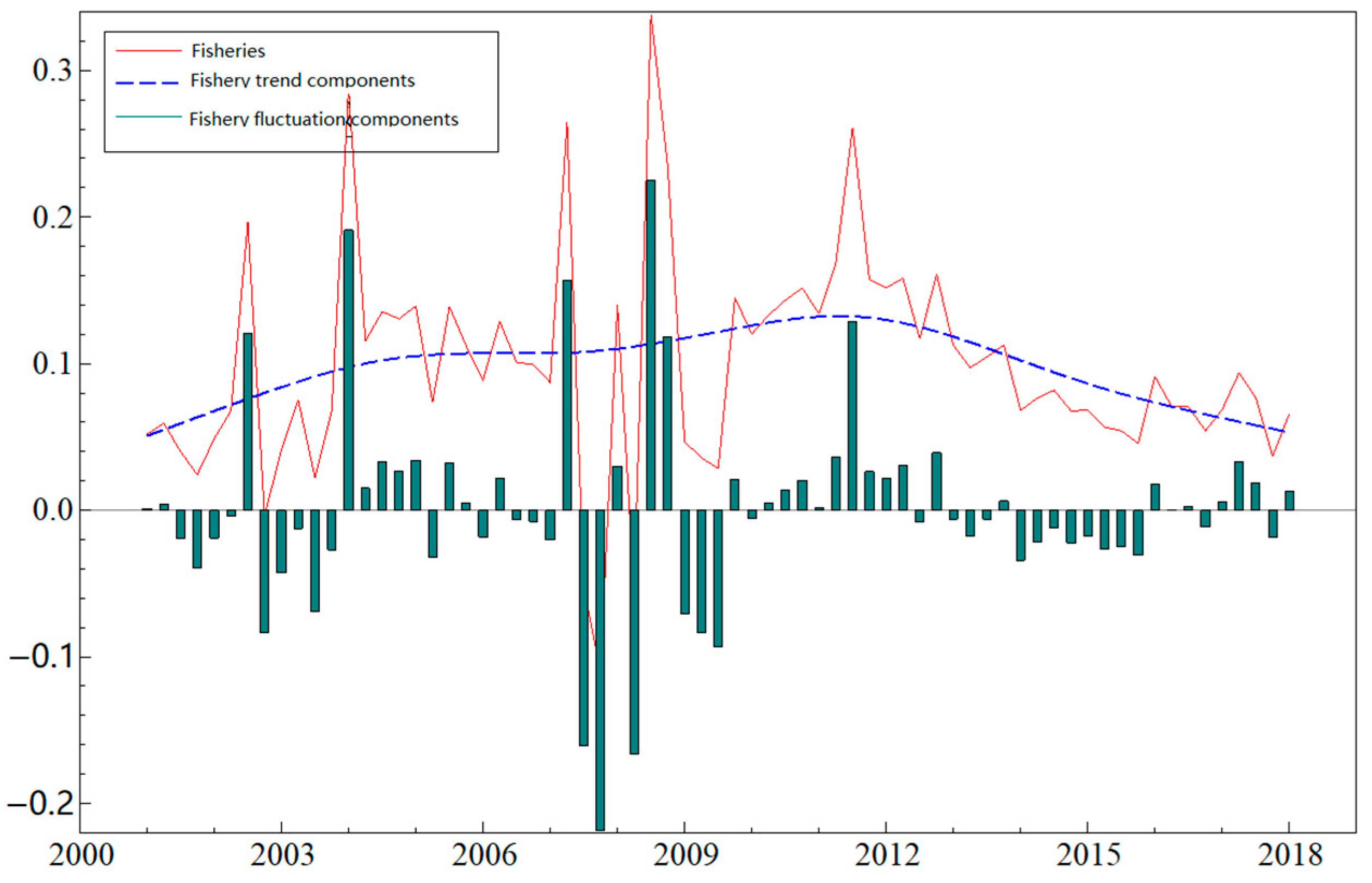
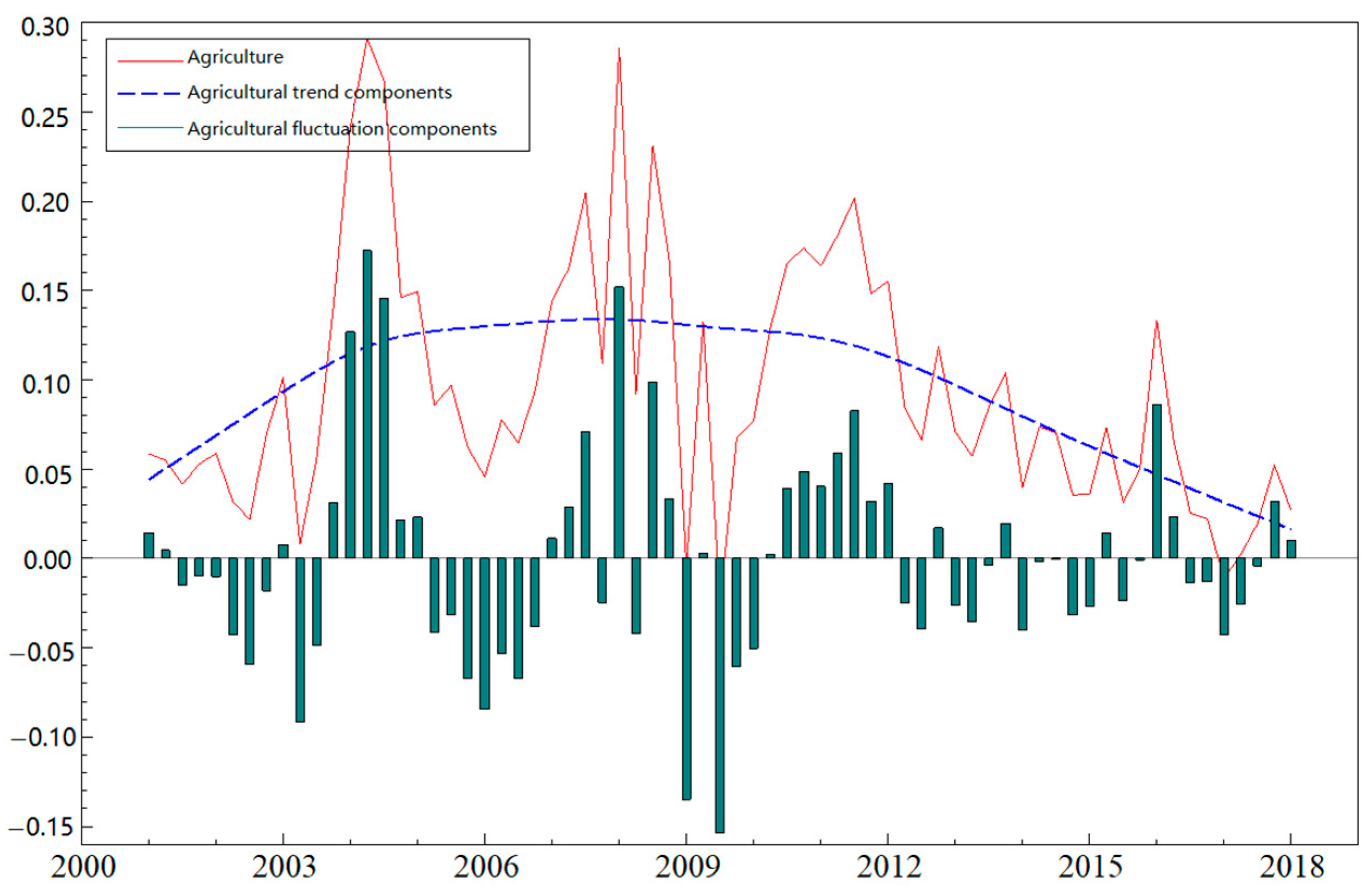
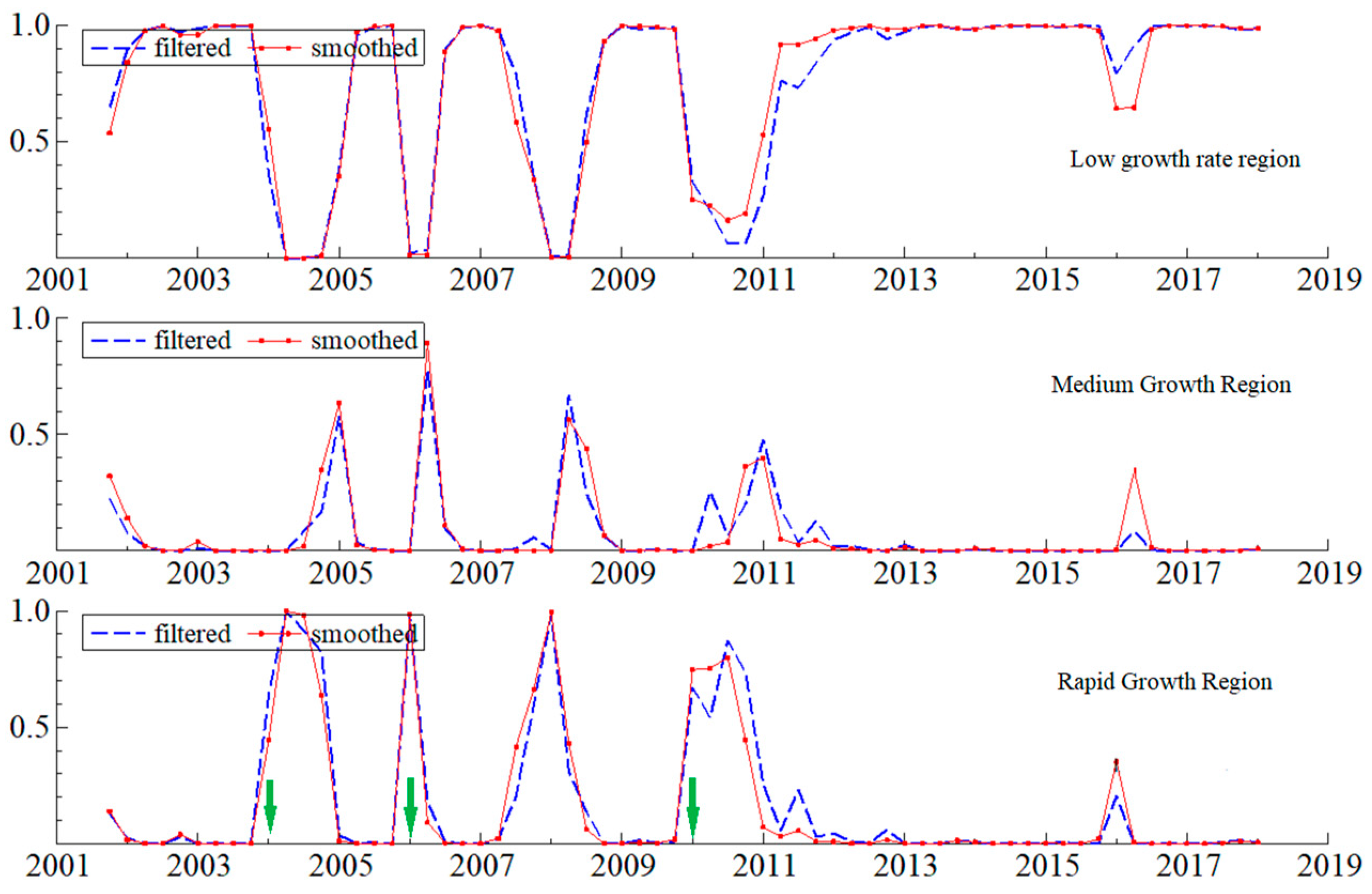

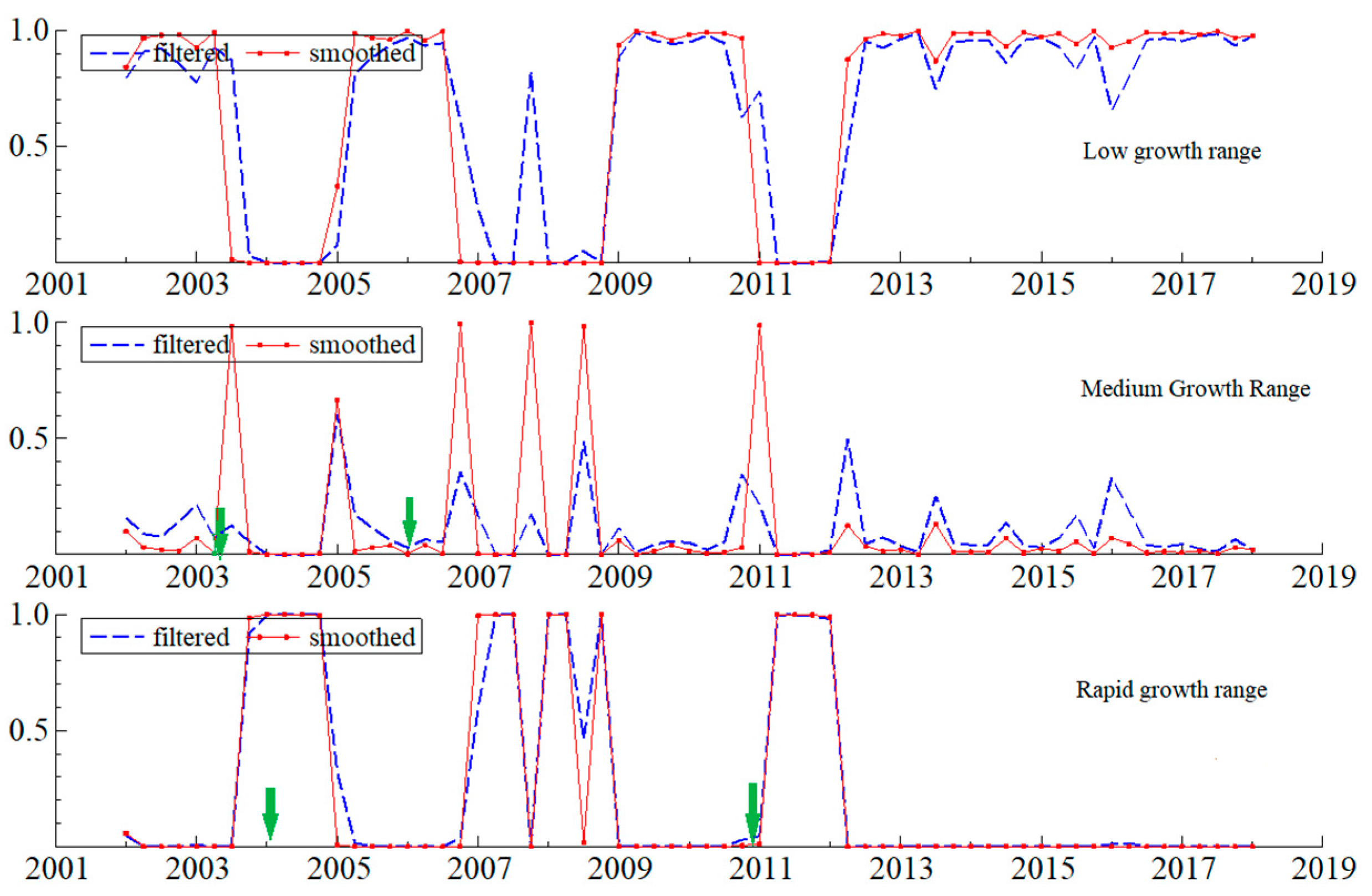
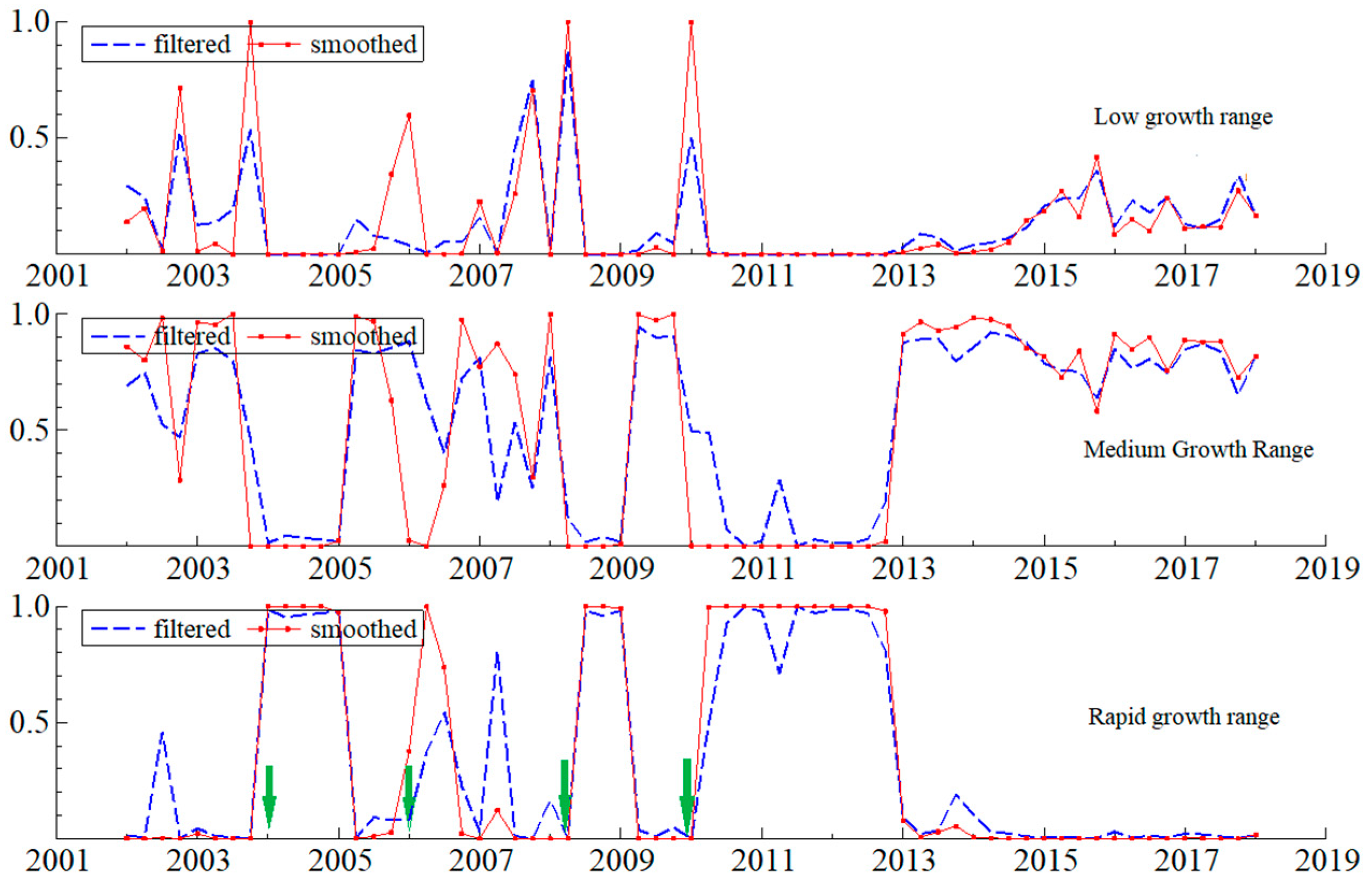

| Regime | Growth Rate of Gross Agriculture Product | Growth Rate of Gross Forestry Product | Growth Rate of Gross Livestock Product | Growth Rate of Gross Fishery Product | ||||
|---|---|---|---|---|---|---|---|---|
| Estimated Value | Standard Deviation | Estimated Value | Standard Deviation | Estimated Value | Standard Deviation | Estimated Value | Standard Deviation | |
| μ1 | 0.0793 ** | 0.0362 | 0.0520 *** | 0.0158 | 0.0277 ** | 0.0125 | 0.0217 | 0.0201 |
| μ2 | 0.1334 *** | 0.0510 | 0.1254 *** | 0.0130 | 0.0809 ** | 0.0343 | 0.0802 *** | 0.0144 |
| μ3 | 0.2057 *** | 0.0392 | 0.7102 *** | 0.0501 | 0.2812 *** | 0.0261 | 0.1685 *** | 0.0205 |
| A1 | 0.3598 ** | 0.1643 | −0.1339 ** | 0.0668 | 0.3666 *** | 0.0732 | −0.3219 *** | 0.1190 |
| A2 | 0.0973 | 0.1808 | -- | -- | −0.1270 | 0.0829 | −0.5408 *** | 0.1085 |
| A3 | 0.1980 * | 0.1185 | -- | -- | 0.2104 *** | 0.0728 | −0.3489 *** | 0.1116 |
| A4 | -- | -- | -- | -- | −0.4658 *** | 0.0684 | −0.6732 *** | 0.1074 |
| Regime | Growth Rate of Gross Agricultural Product | |
|---|---|---|
| Estimated Value | Standard Deviation | |
| μ1 | 0.0617 ** | 0.0268 |
| μ2 | 0.0764 *** | 0.0274 |
| μ3 | 0.1600 *** | 0.0251 |
| A1 | 0.2081 ** | 0.0906 |
| A2 | 0.7292 *** | 0.0975 |
| A3 | 0.2134 ** | 0.0990 |
| A4 | −0.5313 *** | 0.0868 |
| Low-Growth Regime | Medium-Growth Regime | Rapid-Growth Regime | |
|---|---|---|---|
| Low-growth regime | 0.9133 | <0.0001 | 0.0867 |
| Medium-growth regime | 0.9452 | 0.0548 | <0.0001 |
| Rapid-growth regime | <0.0001 | 0.4421 | 0.5588 |
| Low-Growth Regime | Medium-Growth Regime | Rapid-Growth Regime | |
|---|---|---|---|
| Low-growth regime | 0.8937 | 0.0007 | 0.1056 |
| Medium-growth regime | 0.0226 | 0.9774 | <0.0001 |
| Rapid-growth regime | 0.6109 | 0.3891 | <0.0001 |
| Low-Growth Regime | Medium-Growth Regime | Rapid-Growth Regime | |
|---|---|---|---|
| Low-growth regime | 0.9063 | 0.0937 | <0.0001 |
| Medium-growth regime | 0.3023 | 0.0066 | 0.6911 |
| Rapid-growth regime | 0.1461 | 0.1930 | 0.6609 |
| Low-Growth Regime | Medium-Growth Regime | Rapid-Growth Regime | |
|---|---|---|---|
| Low-growth regime | 0.0020 | 0.5515 | 0.4464 |
| Medium-growth regime | 0.2646 | 0.7345 | 0.0009 |
| Rapid-growth regime | <0.0001 | 0.1974 | 0.8026 |
| Low-Growth Regime | Medium-Growth Regime | Rapid-Growth Regime | |
|---|---|---|---|
| Low-growth regime | 0.8425 | 0.1575 | <0.0001 |
| Medium-growth regime | 0.0092 | 0.5909 | 0.3999 |
| Rapid-growth regime | 0.1980 | <0.0001 | 0.8020 |
| Regime | Gross Agriculture Product Growth Rate | Gross Forestry Product Growth Rate | Gross Livestock Product Growth Rate | Gross Fishery Product Growth Rate | Gross Overall Agricultural Product Growth Rate |
|---|---|---|---|---|---|
| Low-growth regime | 11.54 | 9.41 | 10.67 | 1.00 | 6.35 |
| Medium-growth regime | 1.06 | 44.19 | 1.01 | 3.77 | 2.44 |
| Rapid-growth regime | 2.27 | 1.00 | 2.95 | 5.07 | 5.05 |
Publisher’s Note: MDPI stays neutral with regard to jurisdictional claims in published maps and institutional affiliations. |
© 2021 by the authors. Licensee MDPI, Basel, Switzerland. This article is an open access article distributed under the terms and conditions of the Creative Commons Attribution (CC BY) license (https://creativecommons.org/licenses/by/4.0/).
Share and Cite
Guo, X.; Lung, P.; Sui, J.; Zhang, R.; Wang, C. Agricultural Support Policies and China’s Cyclical Evolutionary Path of Agricultural Economic Growth. Sustainability 2021, 13, 6134. https://doi.org/10.3390/su13116134
Guo X, Lung P, Sui J, Zhang R, Wang C. Agricultural Support Policies and China’s Cyclical Evolutionary Path of Agricultural Economic Growth. Sustainability. 2021; 13(11):6134. https://doi.org/10.3390/su13116134
Chicago/Turabian StyleGuo, Xiangdong, Pei Lung, Jianli Sui, Ruiping Zhang, and Chao Wang. 2021. "Agricultural Support Policies and China’s Cyclical Evolutionary Path of Agricultural Economic Growth" Sustainability 13, no. 11: 6134. https://doi.org/10.3390/su13116134
APA StyleGuo, X., Lung, P., Sui, J., Zhang, R., & Wang, C. (2021). Agricultural Support Policies and China’s Cyclical Evolutionary Path of Agricultural Economic Growth. Sustainability, 13(11), 6134. https://doi.org/10.3390/su13116134






